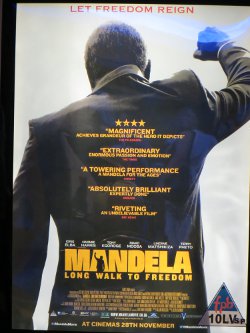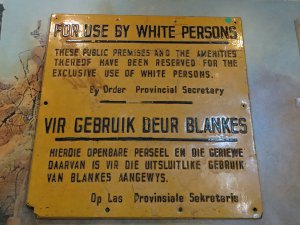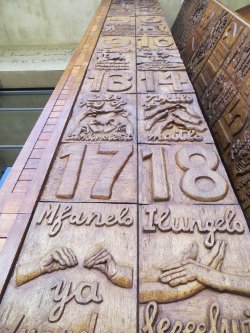Struggle for Freedom
The history of South Africa is without a doubt one of the aspects that touched us the most during our stay in the country. While traveling we visited different museums including: Iziko Slave Lodge Museum, District Six Museum, and Robben Island Museum in Cape Town; KwaMuhle Museum in Durban; the Apartheid Museum and Constitution Hill in Johannesburg, Hector Pieterson Museum and Nelson Mandela’s House in Soweto. Furthermore, reading Nelson Mandela’s autobiography “Long Walk to Freedom” as well as watching the recently released movie inspired by his book, gave us a better understanding of South Africa’s struggle for freedom until it finally became a democratic nation, one man one vote, in 1994.

With this article we are not trying to resume the entire history of South Africa or the multiple lessons we learned. Our objective is just to present some important aspects regarding their struggle with the hope that they will intrigue you to research and reflex on the issues of racism, slavery, and inequality all over the world. We believe the history of South Africa needs to be taken as an example of what should not be allowed to continue happening. We all should know that racism and oppression is a prejudice that manifests at different levels in the minds and actions of many human beings. A current example of this happening now is the estimated 12.3 million adults and children that are trapped in various forms of forced labor. UNICEF estimates that 1.2 million children are trafficked worldwide every year in a thriving trade that is increasing. To be able to liberate the oppressed we need to liberate the oppressor because they are prisoners of their own fears and misconceptions.
As we discovered in the Iziko Slave Lodge Museum, slaves were introduced to South Africa in 1658 six years after the Dutch East India Company established a refreshment station in Cape Town. Slaves were imported from India, Sri Lanka, Indonesia, Madagascar, West, Central, and East Africa. Under-nourished and purposely ill-treated, a slave’s life expectancy was, on average, 15 years. Slaves living at the Cape were emancipated on December 1, 1834 but they were not freed. Until 1838 they were apprenticed to their former owners without pay. In South Africa, colonial slavery contributed to a society based on racial oppression. After the abolition of slavery, laborer’s freedom of movement was severely restricted by the master and servants legislation. In the late 1800’s, the demand for cheap labor by the mining industry entrenched segregation and promoted a low wage economy which greatly benefited white South Africans. Only the constitution of the Republic of South Africa in 1996 prohibited slavery and forced labor.

Racism in South Africa was based on the principal of white superiority and domination. We learned from a great exhibition in Constitution Hill that leaders like Gandhi were impacted, shaped, and inspired to fight against segregation after their living experience in this country. Gandhi said: “Truly speaking, it was after I went to South Africa that I became what I am now. My love for South Africa and my concern for her problems are no less than for India”. Gandhi promoted the Indian Non-Violence Campaign (Satyagraha) on September 11, 1906 at a mass meeting in Johannesburg’s. Three thousand Indians from all over the Transvaal were mobilized to oppose the government regulations.
Regarding Gandhi’s non-violence campaign he explained: “I learned the lesson of non-violence from my wife when I tried to bend her to my will. Her determined resistance to me ultimately made me ashamed of myself and cured me of my stupidity in thinking that I was born to rule over her, and in the end she became my greatest teacher in non-violence”. Gandhi was imprisoned several times in South Africa during his campaign for equality and he left for India on July 18, 1914, exactly four years before Nelson Mandela was born, having laid the foundation for the non-violence resistance struggles that were to follow.
Johannesburg’s Apartheid Museum walked us through tons of information where we learned that Apartheid is where it belongs, in a museum! Apartheid was born as a new term to reinforce the existing racism in 1948. The word Apartheid means “apartness” and it represented the codification in one oppressive system of all the laws and regulations that had kept black Africans in an inferior position to whites for centuries. The policy was supported by the Dutch Reform Church, which furnished Apartheid with its religious underpinnings by suggesting that “Afrikaners (white South Africans of Dutch origin) were God’s chosen people and that blacks were a subservient species”. The victory of Apartheid and Afrikaners’ nationalism was the beginning of the end of the domination by the Englishmen in South Africa. Without an attempt to justify it, their nationalist movement was as well a response to the oppression they had endured under the British domination. And for the first time in South African history, and exclusively Afrikaner party led the government after the elections of 1948. The intense racism that characterized the Nationalist party got them to openly identify and support with the horrible actions of genocide Hitler and his army were committing in Europe.
Apartheid law placed each individual in one of four groups: African described as Bantu, Colored (mixed race: black and white), Asian, or White. South Africa’s Prime Minister, HF Verwoerd, the architect of Apartheid, said in 1963: “When I have control over native education, I will reform it so that natives will be taught from childhood that equality with Europeans is not for them”. Some of the worst legislation were premeditated and implemented into education with the purpose to perpetuate the racial inequality. Bantu Education which was introduced in 1953 allowed more black children to go to school but their facilities and level of education was poor compared to the one offered to whites. For every 644 rands (South African currency) the government spent on a white student, only 42 rands was spent on a black one. All over the country black Africans were subjected to forced removals from their homes and relocated into townships in absent of the necessary amenities for a decent life. The District Six Museum provided us a perfect example of how an entire black African community was displaced from their homes. Every black African over the age of 16 years old had to carry a “pass” and presented to the authorities upon their demand at any time. Black Africans weren’t free to move and live within the territories of their own country.
Important political leaders like Oliver Tambo and Nelson Mandela from the African National Congress (ANC) continued the non-violence campaign started by the Indian movement without much success. Every time the responses of the government were more oppressive and violent. After facing years of persecution, banning, and massacres of their people, leaders from the ANC questioned their principals of fighting without violence and decided to turn into a military movement. Mandela and other leaders were charged with sabotage and sentenced to life imprisonment on June 12, 1964. The Iziko Slave Lodge Museum had an informative temporary exhibit on Oliver Tambo’s life and how during the years of Mandela’s imprisonment, Tambo kept the movement alive in exile. Without him the liberation and democracy of South Africa would not have been possible.

He was the main international ambassador of the fight against Apartheid and his work helped build up the solidarity of South Africa by placing several economic sanctions that eventually permitted the end of this dark regimen. The process took years because the ANC was labeled as “Communist” during the times of the Cold War, which turned down the support of countries like the USA, Britain, and France in meetings of the United Nations. During the struggle, the Scandinavian countries and the World Council of Churches became the ANC’s biggest allies. Another event that reached international attention was the Soweto uprising in 1976, as we were educated about in the Hector Pieterson Museum, when a peaceful student protest against the introduction of Afrikaans as a language of instruction was violently suppressed by police gun fire resulting in the murder of Hector Pieterson. Eventually, the entire world pushed for a change in South Africa and this is today an historical example of the positive impact and power of international politics.
On February 11, 1990, Mandela was free after 27 years of captivity and devoted himself to work towards reconciliation. While visiting Robben Island we learned that during his imprisonment, Mandela, never gave up on his fight for equality. Studying, educating others, exercising, and gardening were some of his main sources of internal support during the saddest times of his life. While in prison, his right and hunger for freedom became unbreakable as he learned that only while managing his thoughts he could eventually beat his oppressor. Mandela’s autobiography isn’t only a testimony of South Africa’s history, but psychological evidence of the way in which the identity of a person can be formed as he resiliently overcomes the worst pains and struggles. Life stories like his reveal the human capacity to bounce back from adversity without losing principles. After so many years of prison, Mandela’s heart was still intact, his body was captive but his mind was always in touch with the cause of his people. He never abandoned the belief that everyone should be free and exercise their right to live as such while pursuing their happiness. Mandela became the symbol of all the people that sacrificed their life in pro of a free and equal South Africa.
After the first democratic election in April 1994, Mandela became the first president of South Africa and the father of the nation for his endless effort towards reconciliation and the creation of their Constitution. Mandela only wished to be president for a term of 4 years, which made him unique in comparison with so many other African leaders who have turned to corruption after being in power.



Nelson Mandela passed away on December 5, 2013 while we were in South Africa. Although we waited in line for six hours, we were not able to attend his viewing, but we were rewarded by the strong presence, energy, and love that his people and the world felt for him, which was satisfying even for us. His message and the history of South Africa will be forever attached to our hearts and steps…
“I have walked that long road to freedom. I have tried not to falter; I have made missteps along the way. But I have discovered the secret that after climbing a great hill, one only finds that there are many more hills to climb. I have taken a moment here to rest, to steal a view of the glorious vista that surrounds me, to look back on the distance I have come. But I can only rest for a moment, for with freedom come responsibilities, and I dare not linger, for my long walk is not ended”. Nelson Mandela
